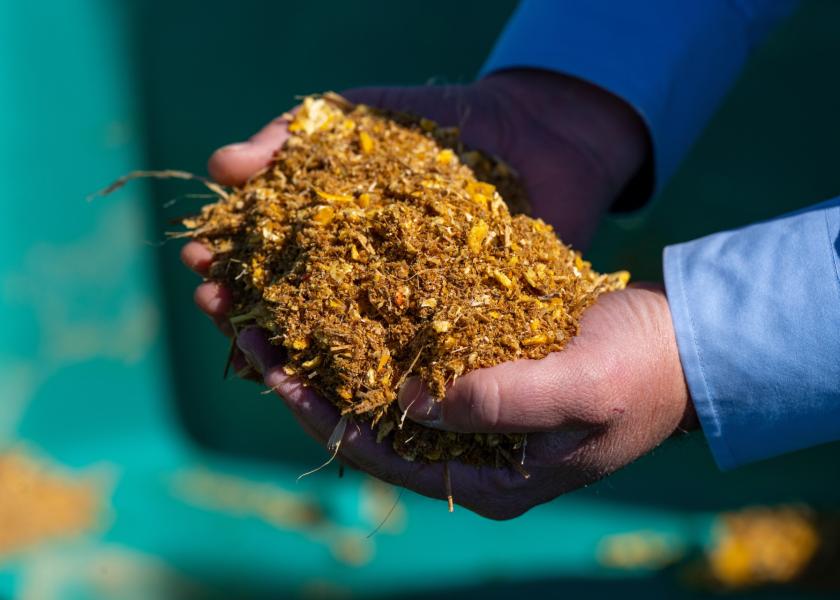Answering the Cattle Nutrition Protein Question

Knowing exactly how beef cattle utilize protein is important to answering many nutrition questions producers and industry nutritionists pose to Texas A&M AgriLife Extension Service specialists like Jason Smith, Ph.D., Amarillo.
Smith, an AgriLife Extension beef cattle nutritionist and associate professor in the Texas A&M College of Agriculture and Life Sciences Department of Animal Science, works one-on-one with producers, AgriLife Extension county agents and other beef industry stakeholders throughout the High Plains of Texas.
One of his primary focus areas is to identify opportunities and conduct the applied research necessary to develop solutions to problems producers face. Protein nutrition is one of those areas. He hopes to empower producers with the ability to make decisions that optimize cattle productivity, are economically advantageous and promote environmental stewardship.
Protein utilization by cattle
“For years, we have had a good appreciation for the concept that cattle utilize different protein fractions to different degrees due to the rumen environment but have historically been limited in our ability to reliably predict the site and extent of protein digestion,” Smith said.
“Making strategic, informed decisions and recommendations involving protein nutrition requires us to predict how and where the animal will digest and utilize protein. Recognizing our previous limitations, filling that knowledge gap became a critical step necessary to help producers and nutritionists meet the nutrient requirements of cattle.”
“Our latest research is making us rethink the values traditionally assigned to some of our major protein ingredients,” Smith said. “We need to rethink how we measure or estimate those values. Fortunately, this project allowed our team to develop prediction equations for producers and nutritionists to use that are both highly accurate and precise.”
The research needed to address this industrywide problem was partly funded by the Texas Cattle Feeders Association and conducted at the joint Texas A&M AgriLife and U.S. Department of Agriculture-Agricultural Research Service research feedyard and metabolism laboratory in Bushland. The team is in the process of publishing the results and has already presented their findings at several major meetings, which have been well received by the industry.
Teamwork to answer the protein availability question
Smith said he often receives questions not being answered by others at this time — there’s a void in the information — and he strives to help answer these questions.
“Protein is one of those areas where we need more information to answer questions that pertain to feeding cattle,” he said. “Not all proteins fed to beef cattle are treated the same in the rumen, and how they are utilized by the animal influences far more than just the amino acids they supply to the animal. Before answering many of these questions with more certainty, we knew we needed to better understand the site and extent to which protein is digested. This was a critical first step for our group.”
Over the past three years, he has collaborated with research colleagues in Texas A&M AgriLife Research and within the Department of Animal Science, as well as with the U.S. Department of Agriculture–Agriculture Research Service at Bushland, to generate science-based answers and bring solutions back to those asking the questions.
Other AgriLife Research members of the team from the Department of Animal Science include Vinícius Gouvêa, DVM, Ph.D., assistant professor and ruminant nutritionist, Amarillo; and Tryon Wickersham, Ph.D., professor and animal nutritionist, and Luis Tedeschi, Ph.D., professor and animal nutritionist, both in Bryan-College Station. From the USDA-ARS Livestock Nutrient Management Research unit at Bushland, researchers include Matt Beck, Ph.D., research animal scientist, and Terra Thompson, Ph.D., research soil scientist.
This study complements the work of Wickersham in protein nutrition and nitrogen metabolism, of Gouvêa in beef cattle nutrition and feeding management, Tedeschi in nutrition modeling, and work by Beck in environmental impact.
Research findings
The research team completed a series of experiments over the past three years that allowed them to not only evaluate the individual protein fractions and their availability to cattle for 18 common feedstuffs, but also to predict them using simple nutrient composition provided by routine feed analyses, Smith said.
“We’ve also begun to conduct some testing to better understand the economic and environmental consequences of under and over-feeding protein to cattle,” he said.
The research will ultimately allow producers and nutritionists to make more strategic supplementation decisions, formulate rations more precisely, and make more informed ingredient purchasing decisions.
“Ultimately, we’re trying to help producers and nutritionists achieve the optimal balance between productivity, economics and environmental stewardship. This work will help us to do that.”
More than just answering questions
The research is an example of the effort to answer more than just scenario-dependent questions, but to provide broader solutions to a greater area of concern within the industry.
Part of that effort is training graduate students like Jarret Proctor and Nate Long, who both work at Bushland, to become tomorrow’s nutritionists and AgriLife Extension personnel. Smith said these students are being trained in a unique way by working in this integrated AgriLife Extension-based applied research field.
“We are using translational research to build a foundation of scientific knowledge but also sharpen it with experiential on-the-ground learning by solving real-world problems,” he said. “These students are working with producers to develop solutions to the problems that they face. The findings of their work are enhancing their ability to do so.”
Smith said the team will continue to refine the process and actively work to further improve the understanding of how feedstuffs interact with the animal to meet its nutrient requirements and to develop estimates that can quickly and economically be incorporated into current laboratory tests.







